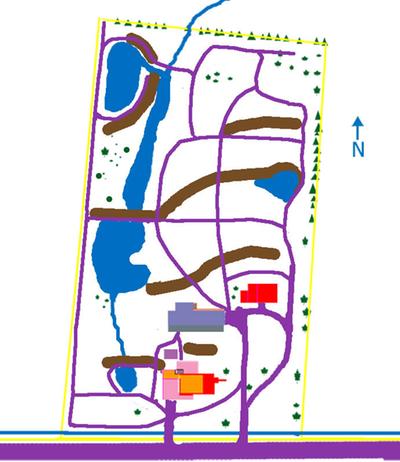I have no idea what to call this plan. Hugeltrench, gray water channels, tree water and feed, zai pit worm nest soil improvement system? That's a bit unwieldy to say. My working name for them is mulch drains, although that's inaccurate, they are on contour, not draining.
I'm wondering if I am making any bad mistakes in my plans, before I start moving dirt.
The concept is easy: when terracing my land, I plan to run the ditch witch through the soil, fill the trenches with rocks, then branches and top with any mulch I can get my hands on. That will give the gray water a place to flow deep in the soil for the trees, and stuff to rot to make zai pit type places where worms will be able to live and start working their way further into the dirt, to improve the soil in the area.
The details: The full soil layout is here
Gardens In My Mind if anyone wants to look. This picture is an overview of the property plan:

The terraces are only going to be 3-5 foot tall, sloped dirt. There's not a lot of slope, but enough to make the water flow right off and it's difficult to work on the slope with equipment, carts, or my health issues. This pic shows from left to right, terrace, swale, mulch drains, tree roots, terrace, swale.

The fill and probable cut looks like this, with the primary lines (on contour or very lightly sloped) having rocks in them as well as branches and mulch, the 90 degrees off contour secondary lines a bit shallower, and having only the branches and mulch. I'm planning to put the house gray water lines to the rock trenches. The tree roots will get there, and take all the water they want, but I think, considering how it works in nature, that the water will continue to flow through the rocks even after the roots start drinking. Won't be a solid X number of feet per minute flow, more a continual seepage saturation channel through there.

Layout on the land, primary channels in gold, secondary channels in pink. Purple is my paths, blue is water ponding areas, brown lines are terraces/dams.

So, does anyone see any obvious problems with this plan? Other than I need a hell of a lot of mulch fill, branches and rocks, still not sure how I'll manage all of that. The land currently grows 5 foot deep pasture grass, and it makes a LOT of clippings to shove in there. Wood debris is all around here, people dump or burn it all the time, manpower to get it back to my place is the primary problem there.
Thank you for input!
:D

 1
1









 1
1




 2
2






 4
4







